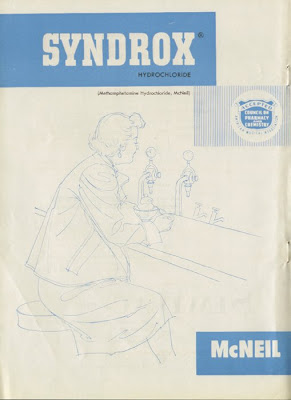Den Pengakåta pillerindustrin har genom åren haft en rad smaklösheter för sig förutom att dölja resultat som talar till sitt preparats nackdel så manipuleras och har det manipulerats en hel del igenom åren. En speciellt intressant grupp att kränga ”de nya supervetenskapliga” produkterna till har varit kvinnor, ofta med någon skavank som medicinjättarna inte alls varit sena med att marknadsföra med vetenskap som täckmantel. Det kan vara den feta kvinnan, den okåta kvinnan, den otacksamma kvinnan eller bara kvinnan som inte hinner med att städa rent i hemmet. Eller varför inte suggan som blivit på smällen och fettnat till? Behöver inte hon lite metamfetamin?

Gravida har alltid haft lite lätt att lägga på sig hullet varför inte ta lite meth amfetamin så att du inte går upp lika mycket i vikt under graviditeten? Feta gravida kärringar gör väl samhället ingen välgärning? Annons till fromma för meth-amfetaminets användande av gravida kvinnor.
 När det tjockande graviditeten gör din kvinna kinkig – ge na lite tjack. Det lättar upp depressionen och gör henne mer arbetsvillig. Annons för D-Amfetamin till gravida honor med graviditetsblues.
När det tjockande graviditeten gör din kvinna kinkig – ge na lite tjack. Det lättar upp depressionen och gör henne mer arbetsvillig. Annons för D-Amfetamin till gravida honor med graviditetsblues.
–
Glad kåt och tacksam
Glad kåt och Tacksam, nu med EXTRA!
Marknadsföringen av Metamfetamin till gravida
När når vi en nyanserad debatt?
Självfallet kan det bland annat liknande annonser och förhållningssätt som ligger till grund för en del av den skeptiskhet som möter behandlingen av adhd med centralstimulerande medel och det är kanske inte så konstigt, eller vad säger du?
Nedan lite om dagens användning av meth amfetamin och en del av texterna som den gamla reklamen härovan så påpassligt verkar glömt bort att berätta. Allt har för och nackdelar, när det ena överdrivs slår det lätt tillbaka åt andra hållet. På samma sätt måste man också kunna belysa medicinindustrins blindgalna krängariver som gång på gång hoppar över alla rimliga gränser och till slut ligger till grund för något som hindrar folkhälsan.
Att stimulerande medel har både för och nackdelar bör väl alla snart kunna veta om? Deras fördelaktighet vid ADHD är det nog ganska många som insett vid det här laget, likförbaskat får inte alla behandling. Vem övervakar det? Samtidigt kan man ändå vara väldigt kritisk till den marknadsföring som medicinjättarna ägnat sig åt i så många år, vilket jag tycker vi visar ganska tydligt här, eller vad säger du?

Methamphetamine Use In Pregnancy Changes Learning Ability Of The Offspring.
METH
Teratogenic effects: Pregnancy Category C. Methamphetamine has been shown to have teratogenic and embryocidal effects in mammals given high multiples of the human dose. There are no adequate and well-controlled studies in pregnant women. METH tablets should
not be used during pregnancy unless the potential benefit justifies the potential risk to the fetus. Nonteratogenic effects: Infants born to mothers dependent on amphetamines have an increased risk of premature delivery and low birth weight. Also, these infants may experience symptoms of withdrawal as demonstrated by dysphoria, including agitation and significant lassitude.
Usage in Nursing Mothers: Amphetamines are excreted in human milk. Mothers taking amphetamines should be advised to refrain from nursing.
Pediatric Use: Safety and effectiveness for use as an anorectic agent in children below the age of 12 years have not been established. Long-term effects of methamphetamine in children have not been established (see WARNINGS). Drug treatment is not indicated in all cases of the behavioral syndrome characterized by moderate to severe distractibility, short attention span, hyperactivity, emotional lability and impulsivity. It should be considered only in light of the complete history and evaluation of the child. The decision to prescribe METH tablets should depend on the physician’s assessment of the chronicity and severity of the child’s symptoms and their appropriateness for his/her age. Prescription should not depend solely on the presence of one or more of the behavioral characteristics. When these symptoms are associated with acute stress reactions, treatment with METH tablets is usually not indicated. Clinical experience suggests that in psychotic children, administration of METH tablets may exacerbate symptoms of behavior disturbance and thought disorder. Amphetamines have been reported to exacerbate motor and phonic tics and Tourette’s syndrome. Therefore, clinical evaluation for tics and Tourette’s syndrome in children and their families should precede use of stimulant medications.
ADVERSE REACTIONS
The following are adverse reactions in decreasing order of severity within each category that have been reported: Cardiovascular: Elevation of blood pressure, tachycardia and palpitation. Fatal cardiorespiratory arrest has been reported, mostly in the context of abuse/misuse. Central Nervous System: Psychotic episodes have been rarely
eported at recommended doses. Dizziness, dysphoria, overstimulation, euphoria, insomnia, tremor, restlessness and headache. Exacerbation of motor and phonic tics and Tourette’s syndrome. Gastrointestinal: Diarrhea, constipation, dryness of mouth, unpleasant taste and other gastrointestinal disturbances.
Hypersensitivity: Urticaria.
Endocrine: Impotence and changes in libido.
Miscellaneous: Suppression of growth has been reported with the
long-term use of stimulants in children (see WARNINGS).
DRUG ABUSE AND DEPENDENCE
Controlled Substance: METH tablets are subject to control under
DEA schedule II.
Abuse: Methamphetamine has been extensively abused. Tolerance, extreme psychological dependence, and severe social disability have occurred. There are reports of patients who have increased the dosage to many times that recommended. Abrupt cessation following prolonged high dosage administration results in extreme fatigue and mental depression; changes are also noted on the sleep EEG. Manifestations of chronic intoxication with methamphetamine include
severe dermatoses, marked insomnia, irritability, hyperactivity, and personality changes.
The
most severe manifestation of chronic intoxication is psychosis often clinically indistinguishable from schizophrenia. Abuse and/or misuse of methamphetamine have resulted in death. Fatal cardiorespiratory arrest has been reported in the context of abuse and/or misuse of methamphetamine.
OVERDOSAGE depressive symptoms should be adequately screened to determine if they are at risk for bipolar disorder; such screening should include a detailed psychiatric history, including a family history of suicide, bipolar disorder, and depression. Emergence of New Psychotic or Manic Symptoms: Treatment emergent psychotic or manic symptoms, e.g., hallucinations, delusional thinking, or mania in children and adolescents without a prior history of psychotic illness or mania can be caused by stimulants at usual doses. If such symptoms occur, consideration should be given to a possible causal role of the stimulant, and discontinuation of
treatment may be appropriate. In a pooled analysis of multiple short-term, placebo-controlledstudies, such symptoms occurred in about 0.1% (4 patients with events out of 3482 exposed to methylphenidate or amphetamine for several weeks at usual doses) of stimulant-treated patients compared to 0 in placebo-treated patients.
Aggression: Aggressive behavior or hostility is often observed in children and adolescents with ADHD, and has been reported in clinical trials and the postmarketing experience of some medications indicated for the treatment of ADHD. Although there is no systematic evidence that stimulants cause aggressive behavior or hostility, patients beginning treatment for ADHD should be monitored for the appearance of or worsening of aggressive behavior or hostility. There is some clinical evidence that stimulants may lower the convulsive threshold in patients with prior history of seizures, in patients with prior EEG abnormalities in absence of seizures, and, very rarely, in patients without a history of seizures and no prior EEG evidence of seizures. In the presence of seizures, the drug should be discontinued. Visual Disturbance Difficulties with accommodation and blurring of vision have been reported with stimulant treatment.
PRECAUTIONS
General: METH tablets should be used with caution in patients with even mild hypertension. Methamphetamine should not be used to combat fatigue or to replace rest in normal persons. Prescribing and dispensing of methamphetamine should be limited to the smallest amount that is feasible at one time in order to minimize the possibility of overdosage. Information for Patients: The patient should be informed that methamphetamine may impair the ability to engage in potentially hazardous activities, such as, operating machinery or driving a motor vehicle.
The patient should be cautioned not to increase dosage, except on advice of the physician. Prescribers or other health professionals should inform patients, their families and their caregivers about the benefits and risks associated with treatment with methamphetamine and should counsel them it its appropriate use. A patient Medication Guide is available for METH. The prescriber or health professional should instruct patients, their families, and their caregivers to read the Medication Guide and should assist them in understanding its contents. Patients should be given the opportunity to discuss the contents of the Medication Guide and to obtain answers to any questions they may have.
Drug Interactions: Insulin requirements in diabetes mellitus may be altered in association with the use of methamphetamine and the concomitant dietary regimen. Methamphetamine may decrease the hypotensive effect of guanethidine. METH should not be used concurrently with monoamine oxidase inhibitors (see CONTRAINDICATIONS). Concurrent administration of tricyclic antidepressants and indirect- acting sympathomimetic amines such as the amphetamines, should be closely supervised and dosage carefully adjusted. Phenothiazines are reported in the literature to antagonize the CNS stimulant action of the amphetamines.
Ämnet är ju ganska allvarlig så därför kan det vara värt att se vad andra säger Meth bubblare, på youtube talaren filmsnutt om världens farligaste drog.
INDICATIONS AND USAGE
Attention Deficit Disorder with Hyperactivity: METH tablets are indicated as an integral part of a total treatment program which typically includes other remedial measures (psychological, educational, social) for a stabilizing effect in children over 6 years of age with a behavioral syndrome characterized by the following group of developmentally inappropriate symptoms: moderate to severe distractibility, short attention span, hyperactivity, emotional lability, and impulsivity. The diagnosis of this syndrome should not be made with finality when these symptoms are only of comparatively recent origin. Nonlocalizing (soft) neurological signs, learning disability, and abnormal EEG may or may not be present, and a diagnosis of central nervous system dysfunction may or may not be warranted. Exogenous Obesity: as a short-term (i.e., a few weeks) adjunct in a regimen of weight reduction based on caloric restriction, for patients in whom obesity is refractory to alternative therapy, e.g., repeated diets, group programs, and other drugs. The limited usefulness of METH tablets (see CLINICAL PHARMACOLOGY) should be weighed against possible risks inherent in use of the drug, such as those described below.
CONTRAINDICATIONS
METH tablets are contraindicated during or within 14 days following the administration of monoamine oxidase inhibitors; hypertensive crisis may result. It is also contraindicated in patients with glaucoma, advanced arteriosclerosis, symptomatic cardiovascular disease, moderate to severe hypertension, hyperthyroidism or known hypersensitivity or idiosyncrasy to sympathomimetic amines. Methamphetamine should not be given to patients who are in an agitated state or who have a history of drug abuse.
WARNINGS
Tolerance to the anorectic effect usually develops within a few weeks. When this occurs, the recommended dose should not be exceeded in an attempt to increase the effect; rather, the drug should be discontinued (see DRUG ABUSE AND DEPENDENCE).
Serious Cardiovascular Events
Sudden Death and Pre existing Structural Cardiac Abnormalities
or Other Serious Heart Problems:
Children and Adolescents: Sudden death has been reported in association with CNS stimulant treatment at usual doses in children and adolescents with structural cardiac abnormalities or other serious heart problems. Although some serious heart problems alone carry an increased risk of sudden death, stimulant products generally should not be used in children or adolescents with known serious structural cardiac abnormalities, cardiomyopathy, serious heart rhythm abnormalities, or other serious cardiac problems that may place them at increased vulnerability to the sympathomimetic effects of a
stimulant drug.
Adults: Sudden deaths, stroke, and myocardial infarction have been reported in adults taking stimulant drugs at usual doses for ADHD. Although the role of stimulants in these adult cases is also unknown, adults have a greater likelihood than children of having serious structural cardiac abnormalities, cardiomyopathy, serious heart rhythm abnormalities, coronary artery disease, or other seriou
s cardiac problems. Adults with such abnormalities should also generally not be treated with stimulant drugs. Hypertension and other Cardiovascular Conditions: Stimulant medications cause a modest increase in average blood pressure (about 2-4 mmHg) and average heart rate (about 3-6 bpm), and individuals may have larger increases. While the mean changes alone would not be expected to have short-term consequences, all patients should be monitored for larger changes in heart rate and blood pressure. Caution is indicated in treating patients whose underlying medical conditions might be compromised by increases in blood pressure or heart rate, e.g., those with pre-existing hypertension, heart failure, recent myocardial infarction, or ventricular arrhythmia. Assessing Cardiovascular Status in Patients being Treated with Stimulant Medications: Children, adolescents, or adults who are being considered for treatment with stimulant medications should have a careful history (including assessment for a family history of sudden death or ventricular arrhythmia) and physical exam to assess for the presence of cardiac disease, and should receive further cardiac evaluation if findings suggest such disease (e.g., electrocardiogram and echocardiogram). Patients who develop symptoms such as exertional chest pain, unexplained syncope, or other symptoms suggestive of cardiac disease during stimulant treatment should undergo a prompt cardiac evaluation.
Psychiatric Adverse Events
Pre-existing Psychosis:
Administration of stimulants may exacerbate symptoms of behavior disturbance and thought disorder in patients with a pre-existing psychotic disorder. Bipolar Illness: Particular care should be taken in using stimulants to treat ADHD in patients with comorbid bipolar disorder because of concern for possible induction of a mixed/manic episode in suchpatients. Prior to initiating treatment with a stimulant,
METH®
Methamphetamine
Hydrochloride
Tablets, USP only
DESCRIPTION
METH® (methamphetamine hydrochloride tablets, USP), chemically known as (S)-N,?-dimethylbenzeneethanamine hydrochloride, is a member of the amphetamine group of sympathomimetic amines. It has the following structural formula:
CLINICAL PHARMACOLOGY
Methamphetamine is a sympathomimetic amine with CNS stimulant activity. Peripheral actions include elevation of systolic and diastolic blood pressures and weak bronchodilator and respiratory stimulant action. Drugs of this class used in obesity are commonly known as “anorectics” or “anorexigenics”. It has not been established, however, that the action of such drugs in treating obesity is primarily one of appetite suppression. Other central nervous system actions, or metabolic effects, may be involved, for example. Adult obese subjects instructed in dietary management and treated with “anorectic” drugs, lose more weight on the average than those treated with placebo and diet, as determined in relatively short-term clinical trials.
The magnitude of increased weight loss of drug-treated patients over placebo-treated patients is only a fraction of a pound a week. The rate of weight loss is greatest in the first weeks of therapy for both drug and placebo subjects and tends to decrease in succeeding weeks. The origins of the increased weight loss due to the various possible drug effects are not established. The amount of weight loss associated with the use of an “anorectic” drug varies from trial to trial, and the increased weight loss appears to be related in part to variables other than the drug prescribed, such as the physician-investigator, the population treated, and the diet prescribed. Studies do not permit conclusions as to the relative importance of the drug and non-drug factors on weight loss.
The natural history of obesity is measured in years, whereas the studies cited are restricted to a few weeks duration; thus, the total impact of drug-induced weight loss over that of diet alone must be considered clinically limited. The mechanism of action involved in producing the beneficial behavioral changes seen in hyperkinetic children receiving methamphetamine is unknown. In humans, methamphetamine is rapidly absorbed from the gastrointestinal tract. The primary site of metabolism is in the liver by aromatic hydroxylation, N-dealkylation and deamination. At least seven metabolites have been identified in the urine. The biological half-life has been reported in the range of 4 to 5 hours. Excretion occurs primarily in the urine and is dependent on urine pH. Alkaline urine will significantly increase the drug half-life. Approximately 62% of an oral dose is eliminated in the urine within the first 24 hours with about one-third as intact drug and the remainder as metabolites.
METHAMPHETAMINE HAS A HIGH POTENTIAL FOR
ABUSE. IT SHOULD THUS BE TRIED ONLY IN
CLINICAL PHARMACOLOGY. HAVE A NICE DAY.
DN skriver om en:Bee-haviouristic twist. Där bin fick bekanta sig med kokain och vad de ledde fram till, – Oh honey aint that smelly…frågan är väl närmast vilka slutsatser man kan dra av det förutom att det är extremt beroendeframkallande för bin under den omständigheten. Och det kan väl passa bra att avsluta med. Det har dock inte studerats om alla bin kunde bli beroende eller om eventuella Bee-havouristical oddballs de s.k. DAMP-honeybina blev lugnare av kokain som en ADHD likande bi-verkan, men den forskningen kanske kommer. SR går in lite djupare i detaljerna kring studierna utan att börja överdriva.

Windows to nerverending Be-haviouristic semantics & metamorphosis question
*Does Superstition brings bad luck?*
Läs även andra bloggares åsikter om Meth, amfetamin, graviditet, sjuk reklam, ADHD, Medicin,



 När det tjockande graviditeten gör din kvinna kinkig – ge na lite tjack. Det lättar upp depressionen och gör henne mer arbetsvillig. Annons för D-Amfetamin till gravida honor med graviditetsblues.
När det tjockande graviditeten gör din kvinna kinkig – ge na lite tjack. Det lättar upp depressionen och gör henne mer arbetsvillig. Annons för D-Amfetamin till gravida honor med graviditetsblues.